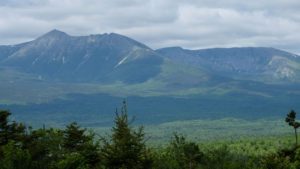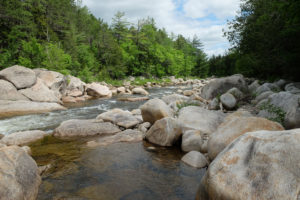For decades, outdoor enthusiasts have wished for—and worked for—a national park in northern Maine. In 2016, their wish came true, partially, when President Barack Obama declared an 87,500-acre tract as the 413th unit of the National Park Service. On August 24, Katahdin Woods and Waters National Monument became real.
The path to a new NPS property has been as rugged as the country that it now occupies. The northern region of Maine, an area of more than 10 million acres known as the North Woods, remains one of the most remote, undeveloped parts of the eastern U.S. During 1820-1860, most of that land was sold by the state of Maine in huge parcels to timber companies. For more than a century, timber companies cut trees sustainably, made paper, provided good jobs and maintained a laissez-faire attitude toward other traditional uses of the land—hunting, fishing, hiking and later snowmobiling—by local residents. And those local residents, famous for their independence and distrust of outsiders, liked it that way.

But as the 21st Century approached, the timber economy started to decline. Several mills went bankrupt and timber companies began selling off their lands. Even before that, as the northeastern U.S. began to fill up, some Maine leaders saw the need to put land, even in Maine’s remote North Woods, into protected status. For decades, former governor Percival Baxter bought up lands around Maine’s highest mountain, Mt. Katahdin (5,268 feet in elevation), and eventually donated the land to the state to become Baxter State Park, established in 1931.
Fast forward 70 years to 2011, when Roxanne Quimby announced she wished to donate land in the North Woods to make a national park. Quimby had moved to Maine in 1975, where she began a small company with a local beekeeper, Burt Shavitz. They sold beeswax candles and then hit on a product—Burt’s Bees lip balm—that made them wealthy. Quimby began buying land, including 87,500 acres just east of Baxter State Park.
She donated those acres to the U.S. government for a park, along with $20 million to support its development and another $20 million promised for the future. President Obama signed the park into law on August 24, 2016.

Not everyone is happy about the new national monument. Some local residents object to their loss of free access to the land—commercial timber harvest is illegal, snowmobiling is restricted to just parts of the area, but fishing and hunting and other recreational uses are still allowed. The current governor, Paul LePage, has been a fierce opponent of the national monument, and refused to allow information signs about the park to be posted along state roads. He convinced President Trump to include Katahdin as the only eastern national monument in a review of large monuments that had been approved since 1996.
Although some individuals and local governments still object to the park, the mass of public opinion is in favor. Public and private groups, including businesses, have endorsed the park, as have the majority of public comments submitted in various reviews. Secretary of the Interior Ryan Zinke issued his report in August, 2017. He recommended that Katahdin remain a national monument, with no changes in size, but did suggest that timber harvest be allowed to promote a “healthy forest.” No further action on that recommendation has occurred. And local businesses are beginning to see an uptick in tourism that they hoped for, to replace the declining timber economy.
Katahdin Woods and Waters National Monument, however, remains a largely undiscovered gem. Fewer than 30,000 people visited last year (the National Park Service’s visitor statistics site doesn’t even include the park yet). If you are looking for an eastern park unlikely to be overrun by tourists, head to northern Maine—your campsite, although primitive, awaits!
References:
Abel, David. 2017. In Maine, a national monument may be in peril. The Boston Globe, July 30, 2017. Available at: https://www.bostonglobe.com/metro/2017/07/30/national-monument-peril/pKqoFMHCMVJzNfm5s2hVmO/story.html. Accessed July 2, 2018.
Domonoske, Camila. 2016. In Maine, Land From Burt’s Bees Co-Founder Is Declared A National Monument. NPR, August 24, 2016. Available at: https://www.npr.org/sections/thetwo-way/2016/08/24/491206413/in-maine-land-from-burts-bees-co-founder-is-declared-a-national-monument. Accessed July 2, 2018.
Miller, Kevin. 2017. Interior secretary wants to keep Maine’s Katahdin Woods and Waters National Monument. Portland Press Herald, August 24, 2017. Available at: https://www.pressherald.com/2017/08/24/interior-secretary-wants-to-keep-national-monument-in-maine/. Accessed July 2, 2018.
Natural Resources Council of Maine. National Monument Timeline. Available at: https://www.nrcm.org/projects/forests-wildlife/katahdin-national-monument/national-monument-timeline/. Accessed July 2, 2018.
